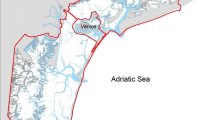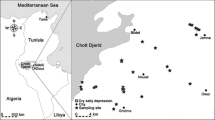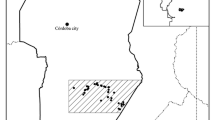Abstract
Since 2005, Morocco has designated 28 Important Bird Areas (IBA) and Ramsar wetlands for waterbirds, yet little is known about how waterbird communities are changing over time and space, within and between sites. We assessed the relationships between species numbers of overall breeding waterbirds, as well as those of Anatidae, Rallidae and Podicipedidae, and geographical, topographical and macrohabitat factors. Species richness of overall waterbirds and Anatidae were positively correlated with: (i) extent of emergent vegetation, (ii) number of plant species present, and (iii) altitude. Species richness of Rallidae was positively correlated with: (i) latitude, and (ii) different beds of emergent vegetation, while that of Podicipedidae was exclusively correlated with altitude. These results suggest that breeding waterfowl are significantly related to habitat characteristics, most importantly vegetation structure, and altitude. Our findings give support to the idea that large mountain wetlands protected areas provide valuable habitat to breeding waterbirds in this region, by providing larger buffer zones with fewer human activities, such as hunting, urbanization and tourism disturbance. This study provides a platform from which we can advance the scientific research on Moroccan IBA and Ramsar wetlands.


Similar content being viewed by others
References
Arzel C, Rönkä M, Tolvanen H, Aarras N, Kamppinen M, Vihervaara P (2015) Species diversity, abundance and brood numbers of breeding waterbirds in relation to habitat properties in an agricultural watershed. Ann Zool Fennici 52(in press)
Atiénzar F, Antón-Pardo M, Armengol X, Barba E (2012) Distribution of the white-headed duck Oxyura leucocephala is affected by environmental factors in a Mediterranean wetland. Zool Stud 51:783–792
Barcena S, Real R, Olivero J, Vargas JM (2004) Latitudinal trends in breeding waterbird species richness in Europe and their environmental correlates. Biodivers Conserv 13:1997–2014
Bartoń K (2013) MuMIn: Multi-model inference. http://CRAN.R-project.org/package= MuMIn
BCEOM-SECA (1995a) Tome 4: Parc Naturel d’Ifrane, Plan Directeur d’Aménagement et de Gestion. Volume no. 1: Propositions. Rabat, Morocco: Administration des Eaux et Forêts et de la Conservation des Sols, Ministère de l’Agriculture et de la Mise en Valeur Agricole
BCEOM-SECA (1995b) Tome 8: Parc National du Haut-Atlas Oriental, Plan Directeur d’Aménagement et de Gestion. Volume no. 1: Propositions. Rabat, Morocco: Administration des Eaux et Forêts et de la Conservation des Sols, Ministère de l’Agriculture et de la Mise en Valeur Agricole
Beatty WS, Kesler DC, Webb EB, Raedeke AH, Naylor LW, Humburg DD (2014) The role of protected area wetlands in waterfowl habitat conservation: implications for protected are network design. Biol Conserv 176:144–152
Benabid A (1982) Bref aperçu sur la zonation altitudinale de la végétation climacique au maroc. Ecolg Med 8(1–2):301–315
Benassi G, Battisti C, Luiselli L (2007) Area effect on bird species richness of an archipelago of wetland fragments of Central Italy. Community Ecology 8:229–237
Bivand R, Altman M, AnselinM L, Assunção R, Olaf B, Bernat A, Blanchet G, Blankmeyer E, Carvalho M, Christensen B, Chun Y, Dormann C, Dray S, Halbersma R, Krainski E, Legendre P, Lewin-Koh N, Li H, Ma J, Millo G, Mueller W, Ono H, Peres-Neto P, Piras G, Reder M, Tiefelsdorf M, Yu D (2012) Spatial Dependence: Weighting Schemes, Statistics and Models, version 0.5–46. <http://CRAN.R-project.org/package=spde>
Burnham KP, Anderson DR (2002) Model selection and multimodel inference: a practical information theoretic approach. Springer, New York
Cardador L, Carrete M, Mañosa S (2011) Can intensive agricultural landscapes favour some raptor species? The marsh harrier Circus aeruginosus in Northeastern Spain. Anim Conserv 14:382–390
Cherkaoui I, Bouajaja A, Elbanak A, Lahrouz S, Hanane S (2014) The black-necked grebe (Podiceps nigricollis): an expanding species in the Middle Atlas wetlands Morocco. Wetlands Ecol Manage 22:93–98
Cherkaoui I, Dakki M, Lahrouz S, Hanane S (2013) Ten-year survey of breeding anatidae of Lake Sidi Boughaba (North-western Marocco): status, tendencies of change and avenues for future research. Rev. Écol. (Terre Vie) 68(2):167–180
Cox RR, Afton AD (1997) Use of habitats by female northern pintails wintering in southwestern Louisiana. J. Wild. Manage. 61:435–443
Dakki M, El Agbani MA, Qninba A (2011) Zones humides du maroc inscrites jusqu'en 2005 sur la liste de la Convention de Ramsar. Travaux Institut Scientifique, Rabat, Série Générale 7: 238 pp
Dakki M, Qninba A, El Agbani MA, Benhoussa A, Beaubrun PC (2001) Waders wintering in Morocco: national population estimates, trends and site-assessments. Wader Study Group Bull 96:47–59
Defos du Rau P (2005) Ecologie, démographie et conservation d’une espèce gibier rare : la Nette rousse Netta rufina. Université Paul Sabatier– Toulouse III. École Doctorale SEVAB- Sciences Ecologiques Vétérinaires Agronomiques Bioingénierie. 167 pp.
DesGranges JL, Ingram J, Drolet B, Morin J, Savage C, Borcard D (2006) Modelling wetland bird response to water level changes in the Lake Ontario. St Lawrence River Hydrosystem. Environ Monit Assess 113:329–365
Dillon ME, Frazier MR, Dudley R (2006) Into thin air: physiology and evolution of alpine insects. Integr Comp Biol 46:49–61
Donald PF, Pisano G, Rayment MD, Pain DJ (2002) The Common Agricultural PSSolicy EU enlargement and the conservation of Europe’s farmland birds. Agriculture Ecosystems and Environments 89:167–182
Dormann CF, McPherson JM, Araújo MB, Bivand R, Bolliger J, Carl G, Davies RG, Hirzel A, Jetz W, Kissling WD, Kühn I, Ohlemüller R, Peres-Neto PR, Reineking B, Schröder B, Schurr FM, Wilson R (2007) Methods to account for spatial autocorrelation in the analysis of species distributional data: a review. Ecography 30:609–628
Evans DM, Day KR (2002) Hunting disturbance on a large shallow lake: the effectiveness of waterfowl refuges. Ibis 144:2–8
Evans KL, Rodrigues ASL, Chown SL, Gaston KJ (2006) Protected areas and regional avian species richness in South Africa. Biol Lett 2:184–188
Fishpool LDC, Evans MI (2001) Important bird areas in Africa and associated islands: priority sites for conservation. Birdlife International, Cambridge, p. 1144 p
Green AJ (1998) Habitat selection by the marbled teal Marmaronetta angustirostris, ferruginous duck Aythya nyroca and other ducks in the Göksu Delta Turkey in late summer. Rev Ecol Terre et Vie 53:225–243
Green AJ, El Hamzaoui M, El Agbani MA, Franchimont J (2002) The conservation status of Moroccan wetlands with particular reference to waterbirds and to changes since 1978. Biol. Cons. 104:71–82
Holopainen S, Arzel C, Dessborn L, Elmberg J, Gunnarsson G, Nummi P, Pöysä H, Sjöberg K (2015) Habitat use in ducks breeding in boreal freshwater wetlands: a review. European Journal of Wildlife Research 61:339–363
Huston MA (1994) Biological diversity. Cambridge University Press, Cambridge
Jiang XZ, Shen YF, Gong XJ (1983) Aquatic invertebrates of the Tibetan Plateau. Science Press, Beijing
Jiguet F, Godet L, Devictor V (2012) Hunting and the fate of French breeding waterbirds. Bird Study 59:474–482
Keil P, Schweiger O, Kühn I, Kunin WE, Kuussaari M, Settele J, Henle K, Brotons L, Pe’er G, Lengyel S, Moustakas A, Steinicke H, Storch D (2012) Patterns of beta diversity in Europe: the role of climate, land cover and distance across scales. J Biogeogr 39:1473–1486
Kleijn D, Sutherland WJ (2003) How effective are Agri-environment schemes in maintaining and conserving biodiversity? J Appl Ecol 40:947–969
Kleijn D, Cherkaoui I, Goedhart PW, van der Hout J, Lammersma D (2014) Waterbirds increase more rapidly in Ramsar-designated wetlands than in unprotected wetlands. J Appl Ecol 51:289–298
Kloskowski J, Nieoczym M, Polak M, Pitucha P (2010) Habitat selection by breeding waterbirds at ponds with size-structured fish populations. Naturwissenschaften 97:673–682
Kosicki JZ, Chylarecki P (2012) Effect of climate, topography and habitat on species-richness of breeding birds in Poland. Basic and App Ecol 13:475–483
Lee SW, Lee HS, Song MJ (2004) Conservation and status of waterbirds on sihwa reclaimed area. J Korean Wetl Soc 6(1):73–87
Loesch CR, Reynolds RE, Hanson LT (2012) An assessment of re-directing breeding waterfowl conservation relative to predictions of climate change. J Fish Wildlife Management 3:1–22
Lor S, Malecki RA (2006) Breeding ecology and nesting habitat associations of five marsh bird species in western New York. Waterbirds 29:427–436
Lu X (2011) Reproductive ecology of three Tibetan waterbird species, with special reference to life-history alterations along altitudeal gradients. Zool Stud 50(2):192–202
Macarthur RH, Recher H, Cody M (1966) On the relation between habitat selection and species diversity. Amer. Nat. 100:319–327
Madsen J, Pihl S, Clausen P (1998) Establishing a reserve network for waterfowl in Denmark: a biological evaluation of needs and consequences. Biol Conserv 85:241–255
Magin C (2001) Morocco. In Fishpool LDC and Evans MI (Eds.) Important Bird Areas in Africa and Associated Islands: Priority sites for conservation. Newbury and Cambridge UK: Pisces Publications and Birdlife International (BirdLife Conservation Series n° 11)
Martin TE (1993) Nest predation and nest sites. Bioscience 43:523–532
McCain CM, Grytnes, JA (2010) Altitudeal Gradients in Species Richness. In: Encyclopedia of Life Sciences (ELS). Wiley, Chichester
Mertler CA, Vannatta RA (2002) Advanced and multivariate statistical methods: practical application and interpretation. Pyrczak Publishing, Los Angeles
Nummi P, Pöysä H (1993) Habitat associations of ducks during different phases of the breeding-season. Ecography 16:319–328
Pearson RG, Dawson TP, Liu C (2004) Modelling species distributions in Brita a hierarchical integration of climate landcover data. Ecography 27:285–298
Pebesma EJ (2006) The gstat package. - www.gstat.org -
Penteriani V, Gallardo M, Roche P (2002) Landscape structure and food supply affect eagle owl (Bubo bubo) density and breeding performance: a case of intra-population heterogeneity. J Zool 257:365–372
Petkov N (2012) Habitat characteristics assessment of the wetlands with breeding ferruginous duck Aythya nyroca and Pochard A. ferina in Bulgaria. Acrocephalus 32:127–134
Porej D (2002) Vegetation cover and wetland complex size as predictors of bird use of created wetlands in Ohio. Annual report Olentangy River Wetland Research Park. Retrieved August 15, 2008, from https://kb.osu.edu/dspace/handle/1811/95
Quinn GP, Keough MJ (2002) Experimental design and data analysis for biologists. Cambridge: Cambridge University, 2002. Print.
R Development Core Team (2014) R: A language and environment for statistical computing. R Foundation for Statistical Computing, Vienna, Austria. ISBN 3–900051–07–0, URL http://www.R-project.org
Raeside AA, Petrie SA, Nudds TD (2007) Waterfowl abundance and diversity in relation to season, wetland characteristics in South Africa. Afr Zool 42:80–90
Rahbek C, Graves GR (2001) Multiscale assessment of patterns of avian species richness. Proc Natl Acad Sci U S A 98:4534–4539
Ramsar (2015) Ramsar website, Available at: [http://www.ramsar.org/cda/en/ramsar-about-history/main/ramsar/1-36-62_4000_0__]. Last accessed 11 February 2015
Bureau RC (2002) What is the Ramsar Convention on Wetlands? Ramsar Convention Bureau, Gland, Switzerland
Schluter D, Ricklefs RE (1993) Species diversity: an introduction to the problem. Species diversity in ecological communities: historical and geographical perspectives (ed. By Ricklefs RE and Schluter D), pp. 1–12. University of Chicago Press, Chicago
Sebastián-González EC, Fuentes M, Ferrández J, Echevarrías L, Green AJ (2013) Habitat selection of marbled teal and white-headed duck during the breeding and wintering seasons in south-eastern Spain. Bird Conserv Int 23:344–359
Skórka P, Martyka R, Wo’jcik J (2006) Species richness of breeding birds at a landscape scale: which habitat type is the most important? Acta Ornithol 41:49–54
Stafford JD, Horath MM, Yetter AP, Hine CS, Havera SP (2007) Wetland use by mallards during spring and fall in the Illinois and central Mississippi river valleys. Waterbirds 30:394–402
Storch D, Davies RG, Zajícek S, Orme CDL, Olson V, Thomas GH, Ding TS, Rasmussen PC, Ridgely RS, Bennett PM, Blackburn TM, Owens IPF, Gaston KJ (2006a) Energy, range dynamics and global species richness patterns: reconciling mid-domain effects and environmental determinants of avian diversity. Ecol Lett 9:1308–1320
Storch D, Konvička M, Beneš J, Martinková J, Gaston KJ (2003) Distribution patterns in butterflies and birds of the Czech Republic: separating effects of habitat and geographic position. J Biogeogr 30:1195–1205
Storch D, Davies RG, Zajíček S, Orme CDL, Olson V, Thomas GH, Ding TS, Rasmussen PC, Ridgely RS, Bennett PM, Blackburn TM, Owens IPF, Gaston KJ (2006b) Energy, range dynamics and global species richness patterns: reconciling mid-domain effects and environmental determinants of avian diversity. Ecol Lett 9:1308–1320
Stuart RE, Kantrud HA (1974) Breeding waterfowl populations in the prairie pothole region of North Dakota. Condor 76(1):70–79
Sutherland WJ, Pullin AS, Dolman PM, Knight TM (2004) The need for evidence-based conservation. Trends Ecol Evol 19:305–308
Thèvenot M, Vernon JDR, Bergier P (2003) The birds of morocco. British Ornithologists' Union Checklist Series: 20:594 pp
Underwood AJ (1994) On beyond BACI - sampling designs that might reliably detect environmental disturbances. Ecol Appl 4:3–15
VanRees-Siewert KL, Dinsmore JJ (1996) Influences of wetland age on bird use of restored wetlands in Iowa. Wetlands 16:577–582
Vîksne J, Janaus M, Mednis A (2011) Factors influencing the number of breeding water birds in lake engure. Latvia Proc Latvian Acad Sci Sect B 65(5/6):190–196
Voigts DK (1976) Aquatic invertebrate abundance in relation to changing marsh vegetation. Amer. Mid. Nat. 95:313–322
Wang BH, Yuan WH, Wang CM, Huang FS, Tang SH, Lin DW (1992) The Xizang (Tibet) insect fauna and its evolution. Zheng Zhou, China: Henan Science and Technology Publishing House
Zar JH (1984) Biostatistical analysis. Prentice-Hall, Inc., Englewood Cliffs, NJ, p. 717 p
Zhou CP, Ouyang H, Wang QX, Masataka W, Sun QQ (2004) Estimation of net primary productivity in the Tibetan Plateau. Acta Geogr. Sin. 59:74–79
Acknowledgments
We are grateful to David Kleijn and Anthony David Fox for their collaboration. We thank M. Guillemain and an anonymous reviewer and the Editor of Wetlands Journal for their comments and advice. This study was supported by SEO/Birdlife, Spain.
Author information
Authors and Affiliations
Corresponding author
Rights and permissions
About this article
Cite this article
Cherkaoui, S.I., Hanane, S., Magri, N. et al. Factors Influencing Species-Richness of Breeding Waterbirds in Moroccan IBA and Ramsar Wetlands: A Macroecological Approach. Wetlands 35, 913–922 (2015). https://doi.org/10.1007/s13157-015-0682-y
Received:
Accepted:
Published:
Issue Date:
DOI: https://doi.org/10.1007/s13157-015-0682-y




